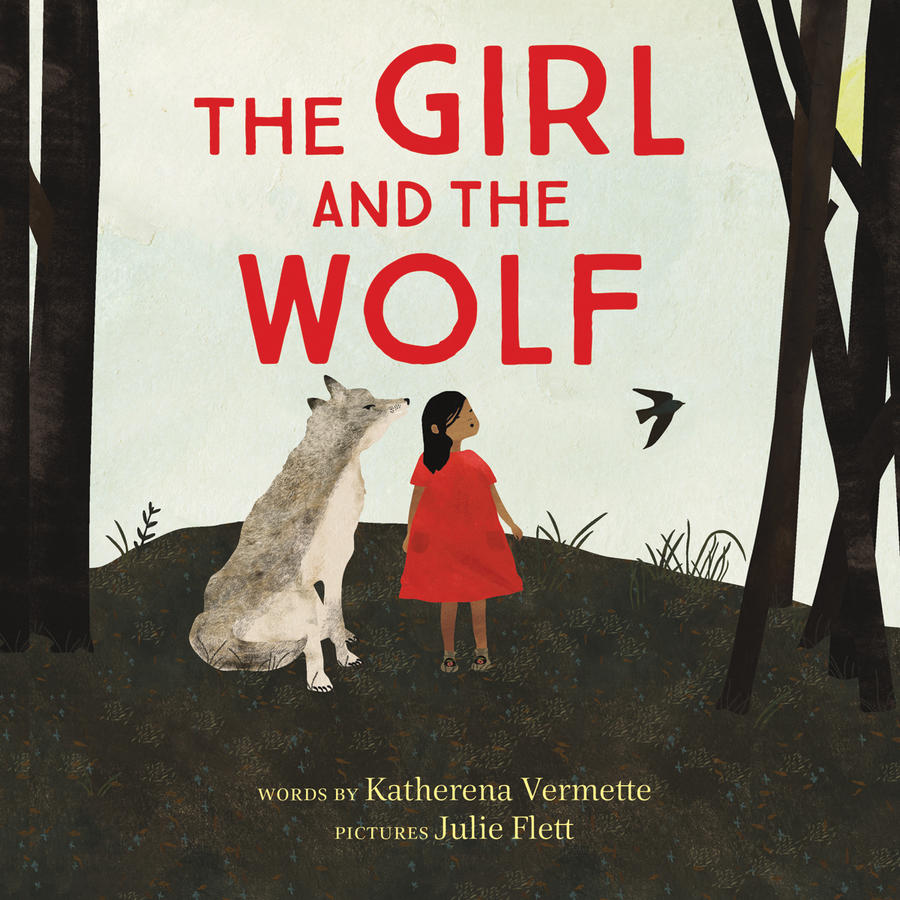 The Girl and the Wolf
The Girl and the Wolf
Written by Katherena Vermette
Illustrated by Julie Flett
Theytus Books, 2019, 32 pp (unpaged)
ISBN: 978-1926886541
The story begins with the innocence of a child at play.
The little girl is running through the bush while her mother is picking berries.
“Don’t go too far,” her mother called. “It’s going to be dark soon.”
“Okay,” the girl said but kept running.
Suddenly the girl looked up and couldn’t see her mother anymore.
The girl is lost, alone, and scared in the bush when a wolf comes along.
Out from between the trees, a tall grey wolf with big white teeth appeared.
The girl was very still.
“What are you doing out here by yourself?” asked the wolf.
“I lost my mother,” she said. “I can’t see my way back.”
Vermette challenges the familiar narrative of the scary wolf who is the antagonist in most fairy tales. The girl is lost with only the wolf to help her, but across the narrative she learns to trust the wolf. The wolf is gentle, protective, friendly, trusting, and calm, challenging the girl to notice her surroundings. The girl follows the wolf’s guidance, and this leads her to trust her inner self and make purposeful decisions that ultimately lead her back to the safety of her mother. The illustrations are simple with clear lines of detail. Flett is careful to give room on the page to honor the trees, birds, and berries. The humans in the picture are not the focus but rather nature that surrounds the girl and her mother. This tribute and esteem of nature is reflective of Indigenous culture.
Vermette includes an Author’s Note to share the inspiration for this fictional story. It was important for the author to show the wolf in a different light from European fairy tales. Many of those stories show the wolf as a scary animal who outsmarts its prey and eats the human. For example, Little Red Riding Hood and The Three Little Pigs show the “Big Bad Wolf” who does harm to humans in the story. The author wants to persuade readers to see the wolf as a gentle loving creature capable of giving care and protection to humans.
Julie Flett’s illustrations make the story come alive. The face of the child and the mother are not detailed, however the detail is on the wolf’s face. The wolf is painted in a light gray and white pinned against the dark gray and black color used for the dark forest. Flett is purposeful in depicting the wolf in a gentle, protective, strong and loving way. Flett uses a butterfly on each page before the child becomes lost and frightened. The color red, symbolizing strength in Indigenous culture, is used to illustrate the child’s dress and the cloth she uses to tie the tobacco gift she left for the wolf in return for helping her find inner strength to make it home.
Readers can extend the theme of appreciating things in nature that typically are feared by reading The Thing About Bees: A Love Letter by Shabazz Larkin (2019). In this text, the author writes to his sons and pays tribute to bees by showing appreciation for the foods they pollinate and the family loves to eat. In both Larkin’s and Vermette’s texts, the stories present a positive relationship between humans and animals/insects that are typically feared. In the same vein, books that demonstrate the value of wolves in an ecosystem can act as a counter-narrative to the fairy tale image of the big bad wolf. One example is When the Wolves Returned: Restoring Nature’s Balance in Yellowstone (Dorothy Hinshaw Patent, Dan Hartman and Cassie Hartman, 2008)
Katherena Vermette is an award-winning novelist, poet, children’s author, and filmmaker. She is a Michif (Red River Métis) from the heart of the Métis Nation in Manitoba, Canada. Born in Winnipeg, her Michif roots are on her paternal side with Mennonite roots on her maternal side. She authored a picturebook series for children that describe the Seven Teachings of the Anishinaabe (love, wisdom, humility, courage, respect, honesty, and truth) as well as the graphic novel series profiling a young teen Métis called Echo. More information can be found on her website.
Julie Flett is a Cree–Métis author, illustrator, and artist who has received numerous awards for her books, including two Governor General’s Awards, the American Indian Library Association Award, and the TD Canadian Children’s Literature Award. Her books reflect many aspects of Indigenous life such as the joy of cross-generational relationships (Birdsong, 2019). Many of her titles are bilingual in English and Cree (Let’s Go!, 2024). More information can be found on her website.
Willeena Booker, Hatboro-Horsham School District
© 2024 by Willeena Booker

